
Actueel - Detail
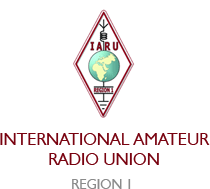
Op zaterdag 15 mei 2010, van 04:00 tot 08:00 UTC, organiseert de IARU een "Global Simulated Emergency Test". De oefening vindt plaats op of rond de emergency Centre-of-Activity (CoA) frequenties op 80, 40, 20, 17 en 15 meter. De gebruikte modes zijn zowel SSB, data als CW.
De doelstellingen van deze oefening zijn:
1. de belangstelling in noodcommunicatie vergroten,
2. de bruikbaarheid van de CoA frequenties testen,
3. ervaring opdoen in internationale noodcommunicatie en,
4. het doorsturen van berichten in alle modes oefenen.
Deze activiteit is geen contest. Van de deelnemers wordt verwacht dat ze berichten in een bepaalde structuur doorsturen naar de de headquarter stations van de verschillende IARU regio's.
Om een werkelijke noodsituatie zo goed mogelijk te simuleren wordt gevraagd het zendvermogen te beperken tot 100W.
Radioamateurs die de intentie hebben om deel te nemen aan deze oefening dienen zich in te schrijven via hun nationale noodnet coördinator. Voor alle Belgische radioamateurs is dit uitsluitend via de UBA radionoodnet (B-EARS) verantwoordelijke b-ears [at] uba [dot] be (ON4AVJ) (b-ears [at] uba [dot] be).
Verdere informatie vind je in dit document van IARU-Region 1.
Na inschrijving ontvang je van ON4AVJ verdere instructies.

L' IARU organise le samedi 15 mai 2010, de 04:00 à 08:00 UTC, un "Global Simulated Emergency Test". Cet exercice aura lieu sur ou près du Center of Activity (CoA) des fréquences d'urgences, sur 80, 40, 20, 17 et 15 mètres. Les modes utilisés sont la SSB, la CW et les transmissions numériques.
Les objectifs de cet exercice sont les suivants :
1. susciter l'intérêt pour les communications d'urgence,
2. tester la faisabilité des fréquences CoA,
3. acquérir de l'expérience dans les communications internationales d'urgence et
4. acheminer des messages dans tous les modes de communication.
Cette activité n'est pas un concours. Les participants doivent transmettre des messages selon un certain format aux stations Head Quarter des différentes régions de l'IARU.
Pour simuler une situation d'urgence, il est demandé de limiter la puissance à 100 W.
Les radio amateurs qui ont l'intention de participer à cet exercice sont invités à s'inscrire par l'intermédiaire de leur coordinateur national du réseau d'urgence. Pour les radio amateurs belges tout cela passera exclusivement par le responsable du réseau radio d'urgence UBA (B-EARS) b-ears [at] uba [dot] be (ON4AVJ) (b-ears [at] uba [dot] be).
De plus amples informations peuvent être trouvées dans le document de l'IARU Région 1.
Après inscription, vous recevrez de plus amples instructions de ON4AVJ.
Op zaterdag 8 mei 2010 is het weer zover!
Het programma bestaat traditioneel uit het officiële gedeelte in de voormiddag, gevolgd door een technisch gedeelte met voordrachten en workshops tijdens de namiddag. De hele dag door is er ook een tentoonstelling met zeer uiteenlopende stands, zeker uw bezoek waard. Voor familieleden en “non-techneuten” is een leuk dagprogramma uitgewerkt.
Klik hier om er alles over te weten!
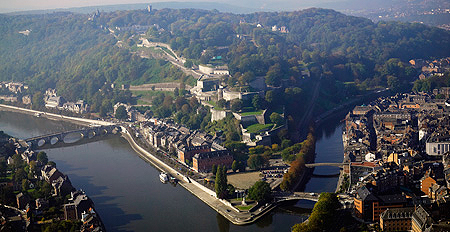
Samedi 8 mai 2010, nous y sommes à nouveau !
Le programme se compose traditionellement l’avant-midi d’une partie officielle et l’après-midi d’une partie technique avec des exposés et ateliers. Durant la journée, une exposition sera ouverte avec différents stands, vraiment un “must”. Pour les autres membres de la famille et “non-technos” un agréable programme est prévu.
Cliquez ici pour en savoir plus !

 Door het ARISS radiocontact in september 2009 en de bijhorende activiteiten zijn een twintigtal leerlingen van het VTI Sint-Lucas (Oudenaarde) door het radiovirus gebeten en hebben in de loop van de voorbije maanden een zendvergunning behaald.
Door het ARISS radiocontact in september 2009 en de bijhorende activiteiten zijn een twintigtal leerlingen van het VTI Sint-Lucas (Oudenaarde) door het radiovirus gebeten en hebben in de loop van de voorbije maanden een zendvergunning behaald.(Info: ON4CGH)
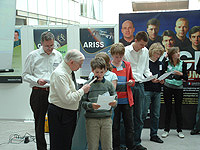 BRUSSELS Tuesday 27 April 2010,
BRUSSELS Tuesday 27 April 2010, 12 students of the European School, Brussels were invited to visit the Exhibition set up by the International Amateur Radio Union in collaboration with the European Space Agency in the European Parliament, Brussels and sponsored by MEP Birgit Sippel, Germany.
The Exhibition's name is "European Amateur Radio Benefiting Society" and the thematics are Emergency, Education and Space. The students, aged 14-18, accompanied by two science teachers, were welcomed by ARISS Chairman Gaston Bertels, ON4WF who introduced the event with a general presentation on the orbital and technical aspects of VHF communications between amateur radio ground stations and the ISS.
The students asked many interesting questions while they observed the projection of the world map showing the ISS progressing towards Buenos Aires, Argentina. An ARISS contact was planned at 12.57 UTC. The radio contact was a telebridge, operated by Adrian Sinclair's ARISS ground station LU1CGB.
When Adrian started calling NA1SS, the audience kept their breath. US astronaut Timothy Creamer, KC5WKI answered immediately and the exchange of questions and answers began. All questions were answered and greetings and thanks exchanged.
 In the European School, located in the outskirts of Brussels, an audience of students and teachers followed the space talk by listening in to the teleconference. In the European Parliament, several MEP and assistants, parents working in the European Commission, as well as representatives of the European Space Agency, assisted to the event.
In the European School, located in the outskirts of Brussels, an audience of students and teachers followed the space talk by listening in to the teleconference. In the European Parliament, several MEP and assistants, parents working in the European Commission, as well as representatives of the European Space Agency, assisted to the event. The contact was distributed over EchoLink and IRLP networks by John Spasojevitch, AG9D.
Two hours later, three space travelers representing three Space Agencies visited the Exhibition: ISS Commander Frank De Winne ON1DWN , Robert Thirsk VA3CSA and Roman Romanenko. Thirty more students from several schools joined the audience, as well as several MEP and assistants. Among them former cosmonaut Vladimir Remek, now member of the European Parliament representing the Czech Republic. Speaking for the European Parliament, MEP Knut Fleckenstein, Germany heartily welcomed the astronauts.
Gaston Bertels, ARISS Chairman addressed the audience in these terms:
Honorable Members of the European Parliament,
Dear Astronauts and Cosmonaut,
Dear students, Ladies and Gentlemen,
It's a memorable day, when three Space travelers visit this Earth bound vessel, where 785 representatives of 27 nations meet in 20 committees and debate for the welfare of 500 million citizens.
It's a memorable day when three distinguished members of three Space Agencies come to visit an Exhibition devoted to the activities of a volunteering community, engaged in Emergency, Education and Space communications.
Accordingly to the Radio Regulations of the International Telecommunications Union, the Amateur service is a radiocommunication service for the purpose of self-training, intercommunication and technical investigations carried out by amateurs, that is, by duly authorized persons interested in radio technique solely with a personal aim and without pecuniary interest and the Amateur Satellite Service is radiocommunication service using space stations on earth satellites for the same purposes as those of the amateur service.
Since the dawn of the Space age, as soon as 1961, radioamateurs have built their own experimental Earth satellites and they continue to do so. Moreover, on Space station MIR, on the American Space Shuttles and presently on the International Space Station, amateur radio equipment is operational and astronauts and cosmonauts, duly licensed radioamateurs, use this equipment mainly for educational purposes.
In collaboration with the Space Agencies, the ARISS organisation sets up educational school contacts, allowing students to put questions to the astronauts and receive their answers, live from Space, via amateur radio. Since 2001, 530 ARISS School Contacts have been performed, the latest one two hours ago, from this very place. During your recent Expedition, Frank and Bob, you have conducted many such School Contacts, fostering the interest of students for science, technology, engineering and maths, the so important STEM studies needed for the future of humanity. In the Columbus module, amateur radio equipment will soon be installed and, in collaboration with the European Space Agency, ARISS is planning the installation in the near future of digital amateur television. When this will be operational, students will not only hear the astronauts but also see them, live in space.
It will be possible for students to imagine microgravity experiments which the astronaut can perform and show during the few minutes of an ARISS School Contact. Some students will build their careers on Space Exploration, in line with the famous sentence "Earth is the cradle of humanity, but one doesn't stay in the cradle forever". This sentence expresses Konstantin Tsiolkovski's vision, Tsiolkovski, whose photo is on the wall of the ISS Service Module, near the ARISS radio. You have also seen it at Energya, in the office of Tsiolkovski's grand-grandson, Sergey Samburov, our colleague in charge of the Russian division of ARISS international.
Dear Frank, Bob and Roman, we would like to offer you a souvenir of your visit. It's a Commemorative Space Talk Certificate, similar to the Certificates which were offered by the Royal Belgian Amateur Radio Union to the participants of the 31 ARISS School Contacts performed by Frank De Winne during his OasISS mission. With all our gratitude for your kind support Thank you!
Photos and a sound recording will be appended to the ARISS bulletin, archived at http://www.ariss-eu.org/2010_04_28.htm ARISS is an international educational outreach program partnering the participating space agencies, NASA, Russian Space Agency, ESA, CNES, JAXA, and CSA, with the AMSAT and IARU organizations from participating countries. ARISS offers an opportunity for students to experience the excitement of Amateur Radio by talking directly with crewmembers onboard the International Space Station.
Teachers, parents and communities see, first hand, how Amateur Radio and crewmembers on ISS can energize youngsters' interest in science, technology and learning.
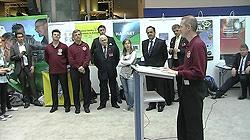 |
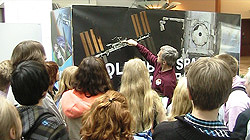 |
| Frank De Winne answers questions from students... | Robert Thirsk VA3CSA answering questions from students... |
Gaston Bertels - ON4WF
ARISS Chairman
Photo on top (left): Student asking a question.
Photo on top (right): From left to right: Gaston Bertels ON4WF, Graham Shirville G3VZV and Frank De Winne ON1DWN
 BRUSSELS Tuesday 27 April 2010,
BRUSSELS Tuesday 27 April 2010, 12 students of the European School, Brussels were invited to visit the Exhibition set up by the International Amateur Radio Union in collaboration with the European Space Agency in the European Parliament, Brussels and sponsored by MEP Birgit Sippel, Germany.
The Exhibition's name is "European Amateur Radio Benefiting Society" and the thematics are Emergency, Education and Space. The students, aged 14-18, accompanied by two science teachers, were welcomed by ARISS Chairman Gaston Bertels, ON4WF who introduced the event with a general presentation on the orbital and technical aspects of VHF communications between amateur radio ground stations and the ISS.
The students asked many interesting questions while they observed the projection of the world map showing the ISS progressing towards Buenos Aires, Argentina. An ARISS contact was planned at 12.57 UTC. The radio contact was a telebridge, operated by Adrian Sinclair's ARISS ground station LU1CGB.
When Adrian started calling NA1SS, the audience kept their breath. US astronaut Timothy Creamer, KC5WKI answered immediately and the exchange of questions and answers began. All questions were answered and greetings and thanks exchanged.
 In the European School, located in the outskirts of Brussels, an audience of students and teachers followed the space talk by listening in to the teleconference. In the European Parliament, several MEP and assistants, parents working in the European Commission, as well as representatives of the European Space Agency, assisted to the event.
In the European School, located in the outskirts of Brussels, an audience of students and teachers followed the space talk by listening in to the teleconference. In the European Parliament, several MEP and assistants, parents working in the European Commission, as well as representatives of the European Space Agency, assisted to the event. The contact was distributed over EchoLink and IRLP networks by John Spasojevitch, AG9D.
Two hours later, three space travelers representing three Space Agencies visited the Exhibition: ISS Commander Frank De Winne ON1DWN , Robert Thirsk VA3CSA and Roman Romanenko. Thirty more students from several schools joined the audience, as well as several MEP and assistants. Among them former cosmonaut Vladimir Remek, now member of the European Parliament representing the Czech Republic. Speaking for the European Parliament, MEP Knut Fleckenstein, Germany heartily welcomed the astronauts.
Gaston Bertels, ARISS Chairman addressed the audience in these terms:
Honorable Members of the European Parliament,
Dear Astronauts and Cosmonaut,
Dear students, Ladies and Gentlemen,
It's a memorable day, when three Space travelers visit this Earth bound vessel, where 785 representatives of 27 nations meet in 20 committees and debate for the welfare of 500 million citizens.
It's a memorable day when three distinguished members of three Space Agencies come to visit an Exhibition devoted to the activities of a volunteering community, engaged in Emergency, Education and Space communications.
Accordingly to the Radio Regulations of the International Telecommunications Union, the Amateur service is a radiocommunication service for the purpose of self-training, intercommunication and technical investigations carried out by amateurs, that is, by duly authorized persons interested in radio technique solely with a personal aim and without pecuniary interest and the Amateur Satellite Service is radiocommunication service using space stations on earth satellites for the same purposes as those of the amateur service.
Since the dawn of the Space age, as soon as 1961, radioamateurs have built their own experimental Earth satellites and they continue to do so. Moreover, on Space station MIR, on the American Space Shuttles and presently on the International Space Station, amateur radio equipment is operational and astronauts and cosmonauts, duly licensed radioamateurs, use this equipment mainly for educational purposes.
In collaboration with the Space Agencies, the ARISS organisation sets up educational school contacts, allowing students to put questions to the astronauts and receive their answers, live from Space, via amateur radio. Since 2001, 530 ARISS School Contacts have been performed, the latest one two hours ago, from this very place. During your recent Expedition, Frank and Bob, you have conducted many such School Contacts, fostering the interest of students for science, technology, engineering and maths, the so important STEM studies needed for the future of humanity. In the Columbus module, amateur radio equipment will soon be installed and, in collaboration with the European Space Agency, ARISS is planning the installation in the near future of digital amateur television. When this will be operational, students will not only hear the astronauts but also see them, live in space.
It will be possible for students to imagine microgravity experiments which the astronaut can perform and show during the few minutes of an ARISS School Contact. Some students will build their careers on Space Exploration, in line with the famous sentence "Earth is the cradle of humanity, but one doesn't stay in the cradle forever". This sentence expresses Konstantin Tsiolkovski's vision, Tsiolkovski, whose photo is on the wall of the ISS Service Module, near the ARISS radio. You have also seen it at Energya, in the office of Tsiolkovski's grand-grandson, Sergey Samburov, our colleague in charge of the Russian division of ARISS international.
Dear Frank, Bob and Roman, we would like to offer you a souvenir of your visit. It's a Commemorative Space Talk Certificate, similar to the Certificates which were offered by the Royal Belgian Amateur Radio Union to the participants of the 31 ARISS School Contacts performed by Frank De Winne during his OasISS mission. With all our gratitude for your kind support Thank you!
Photos and a sound recording will be appended to the ARISS bulletin, archived at http://www.ariss-eu.org/2010_04_28.htm ARISS is an international educational outreach program partnering the participating space agencies, NASA, Russian Space Agency, ESA, CNES, JAXA, and CSA, with the AMSAT and IARU organizations from participating countries. ARISS offers an opportunity for students to experience the excitement of Amateur Radio by talking directly with crewmembers onboard the International Space Station.
Teachers, parents and communities see, first hand, how Amateur Radio and crewmembers on ISS can energize youngsters' interest in science, technology and learning.
 |
 |
| Frank De Winne answers questions from students... | Robert Thirsk VA3CSA answering questions from students... |
Gaston Bertels - ON4WF
ARISS Chairman
Photo on top (left): Student asking a question.
Photo on top (right): From left to right: Gaston Bertels ON4WF, Graham Shirville G3VZV and Frank De Winne ON1DWN
 BRUSSELS Tuesday 27 April 2010,
BRUSSELS Tuesday 27 April 2010, 12 students of the European School, Brussels were invited to visit the Exhibition set up by the International Amateur Radio Union in collaboration with the European Space Agency in the European Parliament, Brussels and sponsored by MEP Birgit Sippel, Germany.
The Exhibition's name is "European Amateur Radio Benefiting Society" and the thematics are Emergency, Education and Space. The students, aged 14-18, accompanied by two science teachers, were welcomed by ARISS Chairman Gaston Bertels, ON4WF who introduced the event with a general presentation on the orbital and technical aspects of VHF communications between amateur radio ground stations and the ISS.
The students asked many interesting questions while they observed the projection of the world map showing the ISS progressing towards Buenos Aires, Argentina. An ARISS contact was planned at 12.57 UTC. The radio contact was a telebridge, operated by Adrian Sinclair's ARISS ground station LU1CGB.
When Adrian started calling NA1SS, the audience kept their breath. US astronaut Timothy Creamer, KC5WKI answered immediately and the exchange of questions and answers began. All questions were answered and greetings and thanks exchanged.
 In the European School, located in the outskirts of Brussels, an audience of students and teachers followed the space talk by listening in to the teleconference. In the European Parliament, several MEP and assistants, parents working in the European Commission, as well as representatives of the European Space Agency, assisted to the event.
In the European School, located in the outskirts of Brussels, an audience of students and teachers followed the space talk by listening in to the teleconference. In the European Parliament, several MEP and assistants, parents working in the European Commission, as well as representatives of the European Space Agency, assisted to the event. The contact was distributed over EchoLink and IRLP networks by John Spasojevitch, AG9D.
Two hours later, three space travelers representing three Space Agencies visited the Exhibition: ISS Commander Frank De Winne ON1DWN , Robert Thirsk VA3CSA and Roman Romanenko. Thirty more students from several schools joined the audience, as well as several MEP and assistants. Among them former cosmonaut Vladimir Remek, now member of the European Parliament representing the Czech Republic. Speaking for the European Parliament, MEP Knut Fleckenstein, Germany heartily welcomed the astronauts.
Gaston Bertels, ARISS Chairman addressed the audience in these terms:
Honorable Members of the European Parliament,
Dear Astronauts and Cosmonaut,
Dear students, Ladies and Gentlemen,
It's a memorable day, when three Space travelers visit this Earth bound vessel, where 785 representatives of 27 nations meet in 20 committees and debate for the welfare of 500 million citizens.
It's a memorable day when three distinguished members of three Space Agencies come to visit an Exhibition devoted to the activities of a volunteering community, engaged in Emergency, Education and Space communications.
Accordingly to the Radio Regulations of the International Telecommunications Union, the Amateur service is a radiocommunication service for the purpose of self-training, intercommunication and technical investigations carried out by amateurs, that is, by duly authorized persons interested in radio technique solely with a personal aim and without pecuniary interest and the Amateur Satellite Service is radiocommunication service using space stations on earth satellites for the same purposes as those of the amateur service.
Since the dawn of the Space age, as soon as 1961, radioamateurs have built their own experimental Earth satellites and they continue to do so. Moreover, on Space station MIR, on the American Space Shuttles and presently on the International Space Station, amateur radio equipment is operational and astronauts and cosmonauts, duly licensed radioamateurs, use this equipment mainly for educational purposes.
In collaboration with the Space Agencies, the ARISS organisation sets up educational school contacts, allowing students to put questions to the astronauts and receive their answers, live from Space, via amateur radio. Since 2001, 530 ARISS School Contacts have been performed, the latest one two hours ago, from this very place. During your recent Expedition, Frank and Bob, you have conducted many such School Contacts, fostering the interest of students for science, technology, engineering and maths, the so important STEM studies needed for the future of humanity. In the Columbus module, amateur radio equipment will soon be installed and, in collaboration with the European Space Agency, ARISS is planning the installation in the near future of digital amateur television. When this will be operational, students will not only hear the astronauts but also see them, live in space.
It will be possible for students to imagine microgravity experiments which the astronaut can perform and show during the few minutes of an ARISS School Contact. Some students will build their careers on Space Exploration, in line with the famous sentence "Earth is the cradle of humanity, but one doesn't stay in the cradle forever". This sentence expresses Konstantin Tsiolkovski's vision, Tsiolkovski, whose photo is on the wall of the ISS Service Module, near the ARISS radio. You have also seen it at Energya, in the office of Tsiolkovski's grand-grandson, Sergey Samburov, our colleague in charge of the Russian division of ARISS international.
Dear Frank, Bob and Roman, we would like to offer you a souvenir of your visit. It's a Commemorative Space Talk Certificate, similar to the Certificates which were offered by the Royal Belgian Amateur Radio Union to the participants of the 31 ARISS School Contacts performed by Frank De Winne during his OasISS mission. With all our gratitude for your kind support Thank you!
Photos and a sound recording will be appended to the ARISS bulletin, archived at http://www.ariss-eu.org/2010_04_28.htm ARISS is an international educational outreach program partnering the participating space agencies, NASA, Russian Space Agency, ESA, CNES, JAXA, and CSA, with the AMSAT and IARU organizations from participating countries. ARISS offers an opportunity for students to experience the excitement of Amateur Radio by talking directly with crewmembers onboard the International Space Station.
Teachers, parents and communities see, first hand, how Amateur Radio and crewmembers on ISS can energize youngsters' interest in science, technology and learning.
 |
 |
| Frank De Winne answers questions from students... | Robert Thirsk VA3CSA answering questions from students... |
Gaston Bertels - ON4WF
ARISS Chairman
Photo on top (left): Student asking a question.
Photo on top (right): From left to right: Gaston Bertels ON4WF, Graham Shirville G3VZV and Frank De Winne ON1DWN
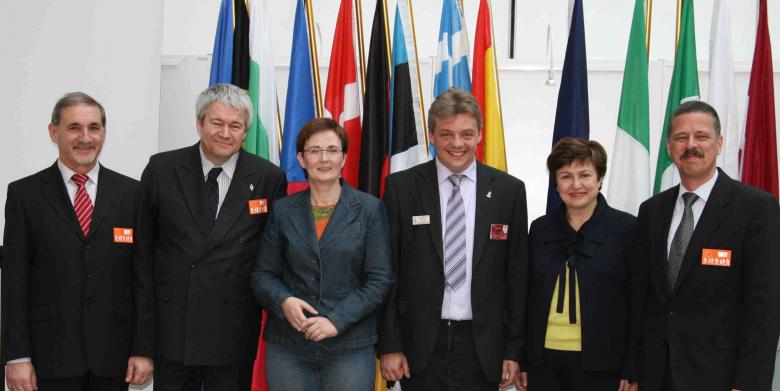
Op 27 april bezocht mevrouw Georgieva de IARU Region 1 tentoonstelling in het Europees parlement en ook daar was ze onder de indruk van onze technische verwezenlijkingen, niet in het minst in het feit dat we zelfs radioverbindingen met het ISS kunnen maken.
Lees het volledige verhaal hier.
Foto: vlnr Panayot LZ1US, Claude ON7TK, Europees parlementslid Brigit Sippel, Thilo DL9KCE, Europees commissaris Kristalina Georgieva en Hans PB2T.

Le 27 avril dernier, Madame Georgieva a visité l'exposition de l'IARU Region 1 qui se tenait au Parlement Européen et là également, elle fut impressionnée par nos réalisations techniques et tout aussi par le fait que nous puissions même réaliser des contacts avec l'ISS.
Retrouvez e verhaal son récit complet.
Photo : de gauche à droite Panayot LZ1US, Claude ON7TK, la parlementaire Européenne Brigit Sippel, Thilo DL9KCE, la commissaire Européenne Kristalina Georgieva et Hans PB2T.



